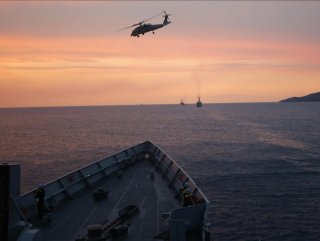
The Turkish Navy is set to conduct massive drills called “Mavi Vatan” – “the Blue Homeland” — between Feb. 27 and March 8. For the first time in the republic’s history, Turkey’s military will test its warfighting capabilities in the Black Sea, Aegean Sea, and the Mediterranean at the same time. The Blue Homeland is not merely an exercise codename, it is also a geopolitical concept that manifests Ankara’s political-military agenda in the coming decade.
AN ACTIVE ROLE FOR TURKISH NAVY IN ENERGY COMPETITON
The Blue Homeland is centered on a trilateral basis. Firstly, the concept has a pronounced power projection aspect. Coupled with Turkey’s burgeoning forward-basing posture across the horn of Africa and the Gulf, Turkey aims at pursuing its national interests in an enhanced zone influence.
Secondly, this understanding adopts a more active role for the Turkish Navy in energy geopolitics competition, coercive efforts, and naval diplomacy. Thirdly and finally, the sustainability of the concept depends on maintaining the uptrend in Turkey’s indigenous defense industry.
Naval power remains at the epicenter of the Blue Homeland. The Turkish Navy is transforming into a blue-water asset with growing power projection capabilities. Without a doubt, the amphibious assault ship project (the TCG Anadolu based on the Spanish Juan Carlos I class LHD), along with Ankara’s plans to operate the vessel as a mini-aircraft carrier with a ski-jump ramp modification, marks the most critical leap in this respect. Notably, for some time, the Turkish administration has been hinting at the prospects of procuring short take-off and vertical landing (STOVL) aircraft — the F-35B — to form a naval aviation air wing in addition to the F-35A acquisition for the air force.
NAVY’S SPECIAL OPERATIONS
The Turkish Navy has benefited from Turkey’s ‘drone breakthrough’, and recently became an operator of indigenous unmanned systems, ANKA and Bayraktar TB-2. Especially, the Bayraktar TB-2 armed drone showed an impressive performance during Operation Olive Branch, and offers one of the most reliable solutions in its class.
Turkey’s battle-hardened amphibious units also deserve attention. Several times, Turkish military planners have deployed these units in active conflict zones to keep them at high combat-readiness. The Navy’s special operations teams (SAS and SAT commandos) fought hard in Operation Euphrates Shield and Operation Olive Branch. Open-source pieces of evidence suggest that detachments from the Amphibious Marine Brigade’s battalions also took part in the cross-border efforts in Syria.
Overall, Turkey is heavily investing in its naval capabilities not only for defending the territorial waters, but also for protecting the country’s sea lines of communication (SloC) and building power projection capacity. Therefore, the Blue Homeland exercises offer a good opportunity to monitor the Turkish Navy’s improving outlook, as well as its joint operations capacity with other branches.
